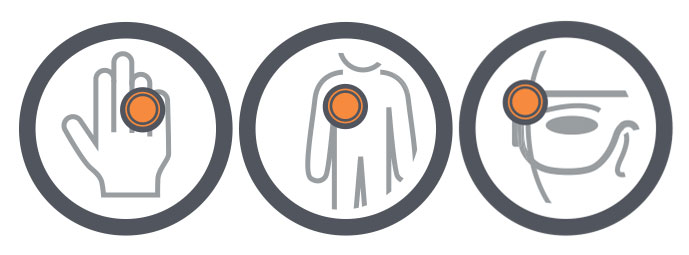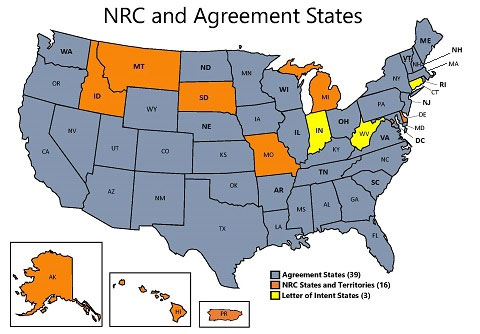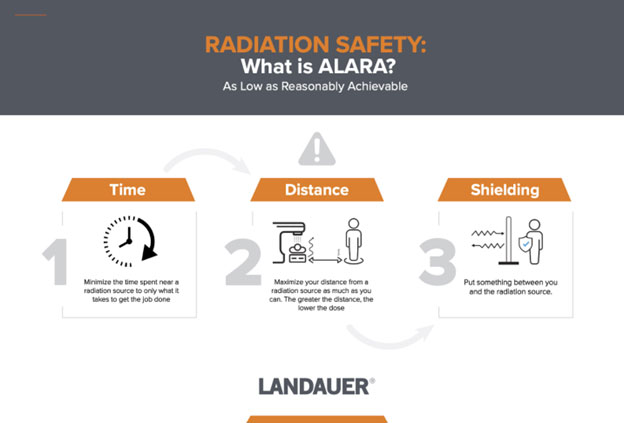
Monitoring Staff and Personnel for Radiation Exposure
The dedicated use of radiation monitoring badges to track how much radiation workers are exposed to on the job is referred to as “personnel radiation monitoring.” Dosimeters are used to monitor staff to help prevent them from exceeding regulatory limits while completing their necessary work on the job. The U.S. Nuclear Regulatory Commission (NRC) has established a threshold in their regulations for the maximum amount of radiation exposure a worker is allowed to receive to the whole body, the lens of the eye, the extremities, and the fetus of a declared pregnant worker.
What is the Purpose of Personnel Monitoring?
The purpose of personnel radiation monitoring is to track radiation exposure among workers in an organized method. Monitoring is most commonly done through a dosimetry program, which uses radiation badges to measure radiation exposure for each individual staff member. LANDAUER manufactures reliable radiation monitoring badges and provides comprehensive reports so workers and their employers can track radiation exposure across staff over time.
What is the Importance of Monitoring Radiation?
Comprehensive monitoring of staff radiation exposure ensures employees working with radiation doses are evaluated in an effort to keep their dose below ALARA (As Low As Reasonably Achievable) limits. This is vital not only for each worker’s peace of mind, but also for organizations to ensure their employees are safe on the job while maintaining compliance with regulations.
Why is it Important to Monitor the Amount of Radiation a Worker Has Been Exposed to?
Any amount of radiation can be dangerous, which is why it’s important to keep radiation exposure levels as low as reasonably achievable through time, distance, and shielding. The U.S. Nuclear Registry Commission has annual ionizing radiation limits. It’s important not to exceed these annual radiation exposure limits to stay within regulatory compliance for the health of staff and personnel. An important note: radiation exposure limits are even lower for declared pregnant workers.
How is Radiation Exposure to Staff Monitored?
Staff monitoring is achieved by providing all workers with their own personal radiation monitoring badges, rings, and/or eye dosimeters to wear for a set period of time. After that period of time ends, the dosimeters are then collected and analyzed to see how much radiation the worker s were exposed to while completing their duties.

LANDAUER provides seamless dosimetry programs, providing dosimeters in regular, pre-determined intervals, analyzing the dosimeters in our NVLAP accredited laboratory (NVLAP Lab Code: 100518-0), and putting together exposure reports efficiently after dosimeters are returned. These reports are the legal dose of record.
Learn more about our dosimeters >>
Regulatory Requirements for Personnel Monitoring
The NRC is the main agency that regulates exposure to ionizing radiation. In addition to exposure limits and requirements, most companies and organizations need to submit applications to the NRC for licenses before being able to work with radioactive materials.

There are numerous other federal and state regulations that can impact compliance around radiation exposure. The NRC has certain Agreement States that are allowed to both license and inspect businesses or organizations that use or have radioactive materials. Nearly 80% of states within the U.S. are agreement states, and in some instances, states have ionizing radiation exposure requirements that are more stringent in comparison to federal standards.
Areas that are not regulated by the NRC or other federal agencies can face additional regulation from the Occupational Safety and Health Administration, or OSHA. OSHA oversees workplace safety in broad terms at the national level. OSHA has ionizing radiation standards for workers who do their work around these types of radiation-emitting materials:
- X-ray machines
- Accelerators
- Ion implanters
- Naturally occurring radioactive material (NORM)
These workers do their jobs in construction, shipyards, marine terminals, longshoring, and other workplaces. OSHA has established its own threshold for radiation exposure. OSHA guidelines require every worker to have a piece of personal monitoring equipment such as a dosimeter. Failure to comply will result in fines or more severe penalties.
No matter which agency is regulating radiation exposure, the process of checking for compliance is the same. Agencies send out inspectors to check for radiation safety compliance, requiring businesses to make any changes if their current radiation protection plan is not following all the necessary rules and regulations.
Safety Practices for Personnel Monitoring

There are important best practices to follow when it comes to the high standards necessary for personnel monitoring. First and foremost is enforcing ALARA, which is adhering to time, distance, and shielding to protect workers from excessive radiation exposure. There are two ALARA investigation levels.
ALARA Investigation Level 1: This is the first notice that a worker is being exposed to higher levels of radiation than anticipated. During this period, the worker is notified in an ALARA memo of their higher results and told to review how they work to see if there are things they can do to cut down on radiation exposure.
ALARA Investigation Level 2: This second investigation is done when workers are recording high levels of radiation exposure that could put them over the required regulatory limit within a year. During this investigation, the RSO or physicist in the program will examine how the person is working and receiving exposure. They will put together new plans to cut down on exposure.
Other important safety practices for personnel monitoring include:
- Properly wearing dosimeters on the body
- Promptly returning dosimeters within the required time frame
- Timely reporting to monitor radiation exposure levels
Frequently Asked Questions About Radiation Monitoring Badges
Can periodic staff monitoring be customized for different job roles?
Yes, LANDAUER offers customizable periodic staff monitoring programs. On top of providing radiation monitoring badges, LANDAUER offers radiation safety compliance consulting and dosimetry support services to help you put together the best radiation protection plan possible for your business and circumstances.
What are the regulatory requirements for periodic staff monitoring?
The NRC is the main regulatory committee for occupational radiation exposure. NRC annual radiation exposure limits are:
- Whole body, blood forming organs, gonads: 5,000mrem/year
- Lens of eye: 15,000 mrem/year
- Extremities and skin: 50,000 mrem/year
- Fetal: 500 mrem/gestation period
- General Public: 100 mrem/year
NOTE: This is based on USNRC Regulations, Title 10, Part 20, Code of Federal Regulations and adopted by many states. Certain states and other regulatory agencies may adhere to different limits.
How does LANDAUER ensure the accuracy and reliability of monitoring results?
LANDAUER sends a control dosimeter with every batch of dosimeters used in staff monitoring programs. The control dosimeters are used to measure the amount of radiation exposure the dosimeters may have received during transport. Upon dosimeter analysis, this amount of exposure is subtracted from the dosimeter reading, since it only occurred in shipping.
What steps does LANDAUER take to protect the privacy of monitoring data?
LANDAUER takes data privacy very seriously. Our team operates on highly protected software to ensure all health data is safely stored and protected.
What should I do if my monitoring report shows high radiation exposure?
If your monitoring report shows high levels of radiation exposure, there are immediate safety steps you can and should take. First, ensure all safety protocols are being followed correctly by your staff. You can request a dosimeter for emergency processing to double-check the levels of radiation exposure. If the individual has levels that could surpass exposure limits, then you can move that person to a position that is not exposed to radiation temporarily or for a longer term as the situation requires.
What Types of Dosimeters & Readers Does LANDAUER Recommend?
LANDAUER has dosimeters designed to make occupational safety simple and easy. One of our most popular radiation monitoring badges is the Luxel+®. This dosimeter can be worn on the whole body or used for area monitoring and is known for its long-term stability.
We also have dosimeters made to be worn at specific parts of the body. The Saturn™ Ring is designed to be worn on the fingers, while LANDAUER Vision® can be clipped to eyewear, visors, or caps for monitoring exposure to the eyes. Meanwhile, RadWatch® can be worn on a person’s wrist and is favored by first responders and those serving in the military.
LANDAUER Dosimeter Subscription Service
Our dosimeter subscription service ensures accurate and reliable staff monitoring and precise dose measurements in any environment where there is potential exposure to ionizing radiations. Our service includes:
- Distribution and collection your dosimeters
- Analysis in our NVLAP accredited lab (NVLAP LAB CODE 100518-0)
- Access to myLDR, our online portal, which provides:
- Individual participant data
- Easy participant changes (add/change/delete)
- Billing information
- Unreturned dosimeter analysis
- Declared pregnant worker information
- Radiation dose reports
- Location management
- Shipment tracking
- And much more!
Look to LANDAUER
Not sure which dosimetry badge is right for you? We’re here to help!


